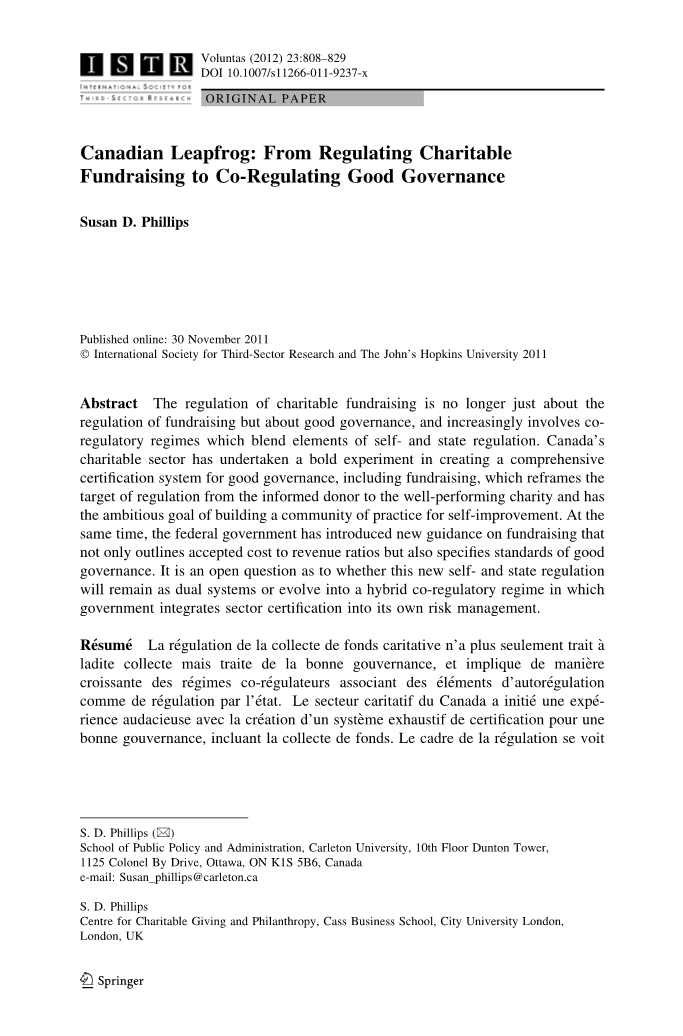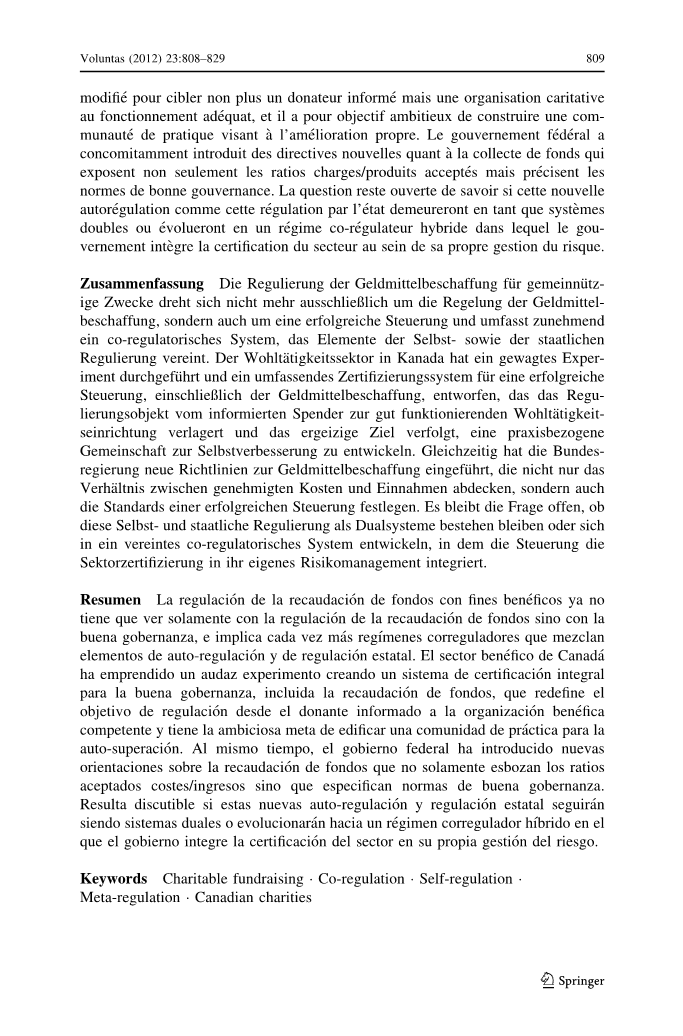

英语原文共 22 页,剩余内容已隐藏,支付完成后下载完整资料
目 录
Regulating from Somewhere: Whatrsquo;s the Problem? Whorsquo;s the Target? 4
英文原文
Canadian Leapfrog: From Regulating Charitable Fundraising to Co-Regulating Good Governance(节选)
Introduction
The regulation of charitable fundraising has become a hard edge where pressures for enhanced public accountability meet private governance. In recent years, a number of countries have introduced or significantly expanded the regulation of charitable fundraising, putting differing emphasis on state regulation, self-regulation, or some combination. This international trend is driven, in part, by a highly competitive environment in which more organizations are chasing limited funds and by technology, particularly the internet, which is changing the nature of fundraising. It is also a reflection of heightened public expectations of radical transparency and the growing presence of the lsquo;lsquo;regulatory statersquo;rsquo; (Jordana and Levi-Faur 2004; Scott 2004) in which prescriptive, rule-based regulation is meeting new forms of self- and co-regulation. A distinctive feature of the evolving regulatory state is not only greater regulation of private governance (e.g., ensuring the governance systems of private organizations are up to state determined standards) but also greater regulation by private governance (e.g., by sector-led certification systems). In line with these broader developments, the recent interest in regulation of charitable fundraising has moved beyond a narrow focus on fundraising per se to encompass the regulation of good governance, and this cannot be achieved by prescriptive regulation.
Canada is at the leading edge of such change. Historically, Canadian governments have been reluctant regulators of charitable fundraising. The provinces, which hold the constitutional authority, have been largely uninterested and the federal government, which as the central tax collector is the de facto regulator of charities, did not push its jurisdictional boundaries to directly regulate fundraising practices. This changed in 2009, partly in response to serious misuse of charities as tax shelters through which over 172,000 Canadians claimed $5.4 billion CDN in donations since 2003 (Hawara 2011). The Charities Directorate of the Canada Revenue Agency (CRA) not only aggressively stepped up monitoring and auditing of possible tax shelters but also established a new Guidance on Fundraising that articulates what constitutes lsquo;lsquo;fundraisingrsquo;rsquo; expenses and sets acceptable ratios of fundraising costs to revenues. This is not particularly distinctive as ratios are commonly used by both governments and independent watchdogs, although they have been widely criticized as irrelevant, bad practice and, indeed, harmful in promoting better public understanding of the charitable sector (Flack 2004; Steinberg and Morris 2010). The more interesting component is that the CRA has identified the governance systems that it expects charities to have in place to reduce the risk of incurring excessive fundraising costs. This potentially represents a more intrusive type of regulation in which the regulator delves into the internal operations of private organizations by identifying and monitoring the leadership, management, control, and evaluation systems that it regards as constituting lsquo;lsquo;good governance.rsquo;rsquo; It remains to be seen whether the CRA will treat such process-oriented regulation (Gilad 2010) as soft guidance or hard rules.
The lead infrastructure organization of the charitable sector, Imagine Canada, also took a huge leap from a 2008 re-launch of a longstanding but under-subscribed voluntary code of ethical fundraising to the development of a comprehensive certification system for good governance, of which fundraising is only one component. The goal of this new certification system is ambitious, intended to build a community of practice for self-improvement. This is a bold move for a sector that has not been particularly supportive of its infrastructure organizations and that until recently saw little need for sector-wide standards at all. If this Standards Program succeeds, it could become a world leader in self-regulation for the charitable sector, but in these early stages there remain many questions about its future—questions which this article explores. It is still uncertain as to how the new government and sector-led systems will work as a regulatory regime. Will they develop as an integrated regime of co-regulation, or exist as separate, dual systems with different regulatory goals, compliance mechanisms, and outcomes? Before assessing the unfolding Canadian experience, it is important to question the assumptions that underpin the regulation of charitable fundraising and briefly examine alternative approaches to both self- and co-regulation, drawing on lessons learned from other sectors about what makes each effective.
Regulating from Somewhere: Whatrsquo;s the Problem? Whorsquo;s the Target?
In a critical assessment of environmental regulation, Kysar (2010) argues that a fundamental problem is that governme
剩余内容已隐藏,支付完成后下载完整资料
资料编号:[254332],资料为PDF文档或Word文档,PDF文档可免费转换为Word
您可能感兴趣的文章
- 通过在消费者心中树立品牌关系导向来提高酒店品牌绩效外文翻译资料
- “友好“抱怨行为:走向亲密的手段外文翻译资料
- 服务蓝图:针对关键服务流程的有效方法-在四星级国际酒店Arash Shahin 管理部进行案例研究外文翻译资料
- 组织中女性高管职业生涯规划与晋升的视角:连锁性别偏见的经验,双重束缚,和不成文的晋升规则外文翻译资料
- 影响优秀员工工作满意度的激励因素识别外文翻译资料
- 探索离职意向的影响因素:以豪华酒店员工为例外文翻译资料
- 新冠肺炎疫情下,中国酒店旅游业面临的挑战与机遇外文翻译资料
- 酒店Twitter账号的营销效果:以沙特阿拉伯为例外文翻译资料
- 酒店旅游市场营销外文翻译资料
- 中国经济型酒店SWOT分析外文翻译资料


